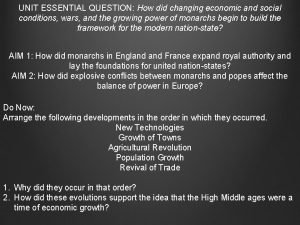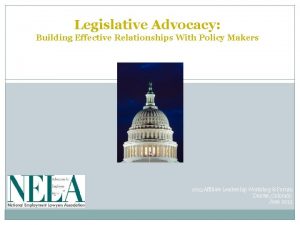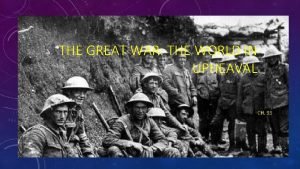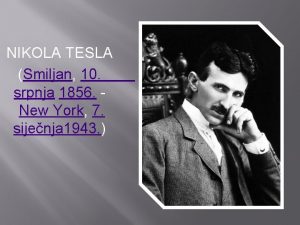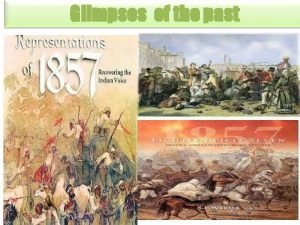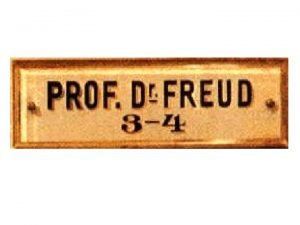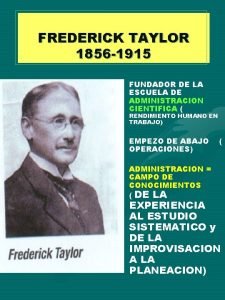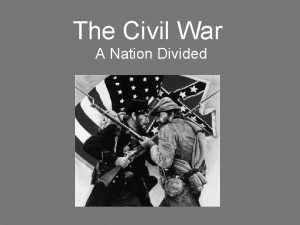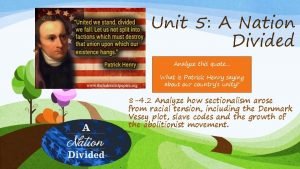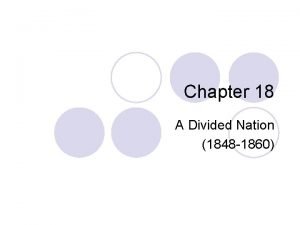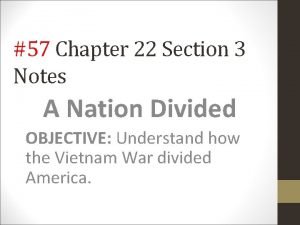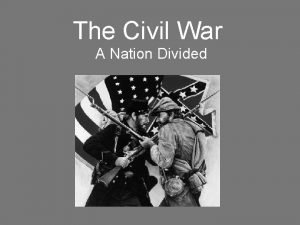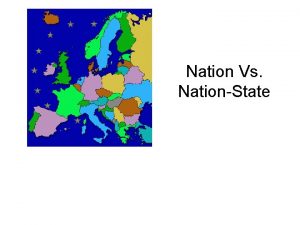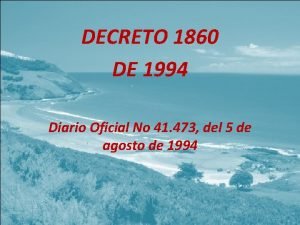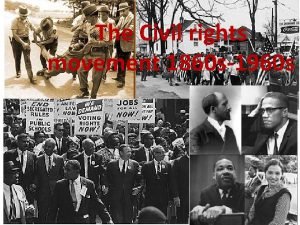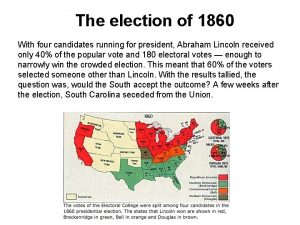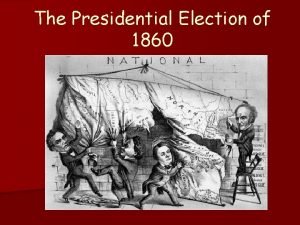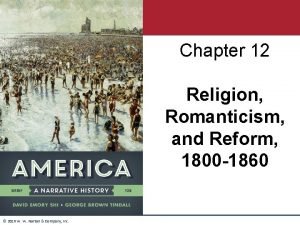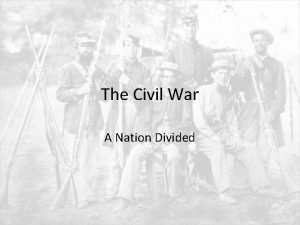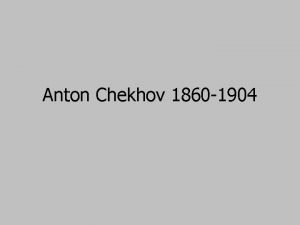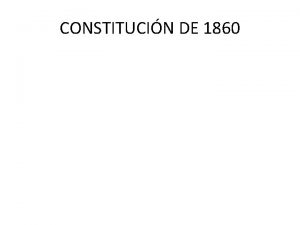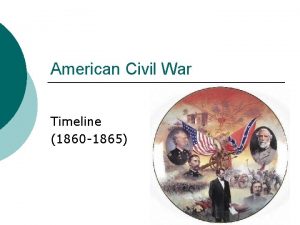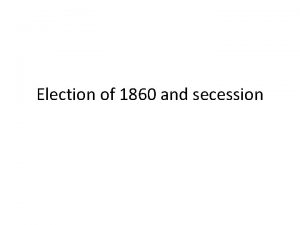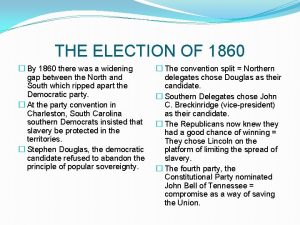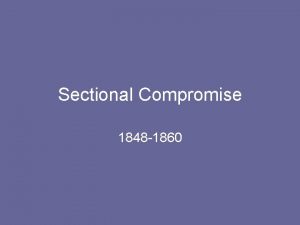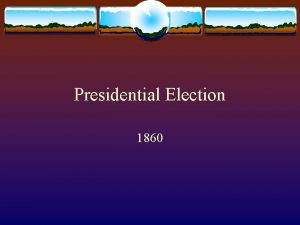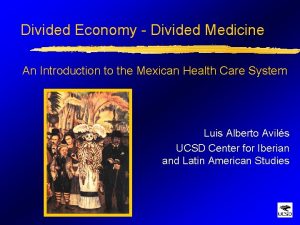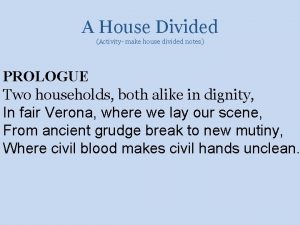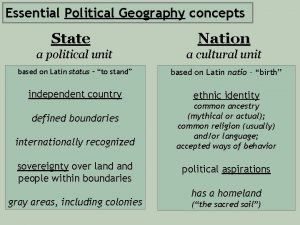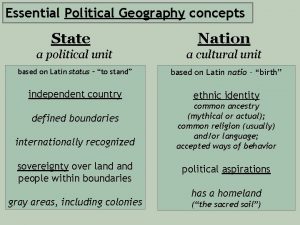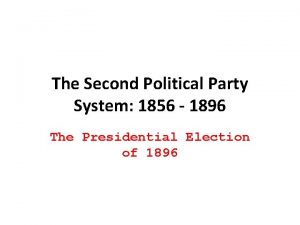The Nation Divided 1856 1860 Political Upheaval in























- Slides: 23

The Nation Divided (1856 -1860)

Political Upheaval in the 1850 s Manifest Destiny intensified sectional differences between the North & the South regarding slavery in the 1840 s & early 1850 s But…the sectional quarrel between the North & the South became “irreconcilable” in the mid-1850 s, especially under James Buchanan (1857 -1860)

Uncle Tom’s Cabin (1852) Harriet Beecher Stowe’s account of slavery became the best selling book of the 19 th century: ◦ Uncle Tom’ Cabin depicted the harsh reality of slavery ◦ The book became a vital antislavery tool among abolitionists

“Bleeding Kansas” (1854 -1858) The Kansas-Nebraska Act (1854) proposed popular sovereignty ◦ The vote to determine slavery in Kansas turned into a bloody small-scale civil war ◦ Republicans benefited from the fighting by using “Bleeding Kansas” propaganda to support their anti-slave cause

Bleeding Kansas • Thousands of pro-slavery Missouri residents crossed the border and voted for slavery • Free-soilers from Kansas voted against slavery • The vote revealed a pro-slavery victory which led to violent uprising – Bleeding Kansas

“Bleeding Sumner” SC Senator Preston Brooks beat Senator Charles Sumner because of a speech Sumner had made criticizing President Pierce & Southerners who supported the pro-slavery violence in Kansas

Sectionalism in Election of 1856 was the first clearly sectional presidential election in U. S. history ◦ Republican John C. Frémont campaigned only in free states ◦ Know-Nothing Fillmore called for sectional compromise ◦ Democrat James Buchanan endorsed popular sovereignty & the Compromise of 1850 Buchanan beat Frémont in the North & beat Fillmore in the South

Southerners were relieved by the victory Thebut Election of 1856 were threatened by the existence of a party devoted to ending slavery Northerners realized that the freestates had a large majority in the Electoral College so a Republican could become president by only campaigning in the North

The Dred Scott Case (1857) In Dred Scott v. Sanford (1857), Taney & the Supreme Court ruled: ◦ Dred Scott arguing he should be free b/c transported from Missouri to Wisconsin ◦ Congress can not prohibit slavery because the gov’t cannot deny citizens their right to property (slaves)

The Lecompton Controversy ■In 1857, Kansas held an election for delegates to write a constitution & apply for statehood –A rigged election led to a pro-slavery Lecompton Constitution –Buchanan tried to push Kansas’ admission through despite the fraud but Congress refused –Kansas was made a free territory, not a slave state

The Lincoln-Douglas Debates ■Democrat Stephen Douglas ran against Republican Abraham Lincoln for the 1858 Illinois Senate ■ Lincoln-Douglas debates Lincoln lost the election, but the debates gained him a national reputation & reaffirmed the Republicans’ uncompromising commitment to the free-soil position

“A house divided against itself cannot stand. I believe this government cannot endure, permanently half slave and half free. ” Abraham Lincoln, 1858

The South's Crisis of Fear ■Two events in 1859 increased Southern fears of North: ■John Brown’s raid on Harper’s Ferry, VA; he & 18 men planned to end slavery in the South by leading slave insurrections: –Brown was caught & executed, but he was perceived by many in the North to be a martyr –Witch-hunts, vigilante groups, & talk of secession grew in South

John Brown’s Body John Brown: Northern Martyr or. John Southern Villain? Brown's body lies amouldering in the grave, John Brown's body lies amouldering in the grave, But his soul goes marching on Glory, glory, hallelujah, His soul goes marching John Brown the martyr on

The South's Crisis of Fear Hinton Helper’s Impending Crisis of the South in 1859: ◦ Helper was a white southerner who argued that slavery hurt the South & small farmers ◦ Southerners saw the book as a plot to rally yeoman against the elite & end slavery

The Election of 1860 The election of 1860 was the final straw for the South Republicans nominated Lincoln: ◦ Illinois was a crucial swing-state ◦ Lincoln was seen as a self-made man who represented equality ◦ His platform of high tariffs for industry, free homesteads in the West, transcontinental railroad widened the party’s appeal

The Election of 1860 Democrats were fatally split: ◦ Northern Democrats nominated Stephen Douglas who ran on a platform of popular sovereignty ◦ Southern Democrats nominated John Breckenridge who swore to protect slavery in the West Ex-Whigs & Know-Nothings formed the Constitutional Union Party & ran John Bell on a compromise platform

The 1860 Election: A Nation Coming Apart North: Abraham Lincoln The Election of 1860 vs. Stephen Douglass During election, 4 nominees ran: ◦ ◦ Republicans Douglas Democrats “Southern Rights” Democrats Constitutional Unionists Competed in North Competed in South: Breckenridge vs. Bell

The Election of 1860 Lincoln won & the South immediately launched a campaign for secession from the Union

Conclusions: Conclusions Explaining the Crisis The North & South argued for two very different ideals of liberty & independence but by the 1850 s, the sectional ideologies made any form of compromise impossible

The Path to War Activity (1820 -1860) In groups of three, complete the “Path to War” chart by explaining: ◦ What each event was ◦ How and why it angered the North and/or the South; Emphasize which region was impacted more When finished, rank order the events (1 to 13)in terms of their significance in causing the Civil War

Class Discussion: Create a class consensus of the most important causes of the Civil War

Class Discussion: At what point from 1820 to 1860 did the United States reach the “point of no return” regarding sectional tensions between North & South?
 How did the combination of plague upheaval in the church
How did the combination of plague upheaval in the church Business with upheaval
Business with upheaval The great war: the world in upheaval
The great war: the world in upheaval Smiljan 1856
Smiljan 1856 1856
1856 Gdje se rodio nikola tesla
Gdje se rodio nikola tesla Smiljan 1856
Smiljan 1856 Whatsapp web
Whatsapp web Amalia freud
Amalia freud Frederick taylor (1856-1915)
Frederick taylor (1856-1915) Freud uuu
Freud uuu A nation divided north vs south answer key
A nation divided north vs south answer key Divided nation quote
Divided nation quote A divided nation section 3
A divided nation section 3 A nation divided chapter 22 section 3
A nation divided chapter 22 section 3 A nation divided: north vs. south
A nation divided: north vs. south State vs nation
State vs nation Example of nation
Example of nation Nation vs state
Nation vs state Decreto 1860 de 1994
Decreto 1860 de 1994 1860
1860 Map of 1860
Map of 1860 The election of 1860 definition
The election of 1860 definition W.w. norton
W.w. norton
